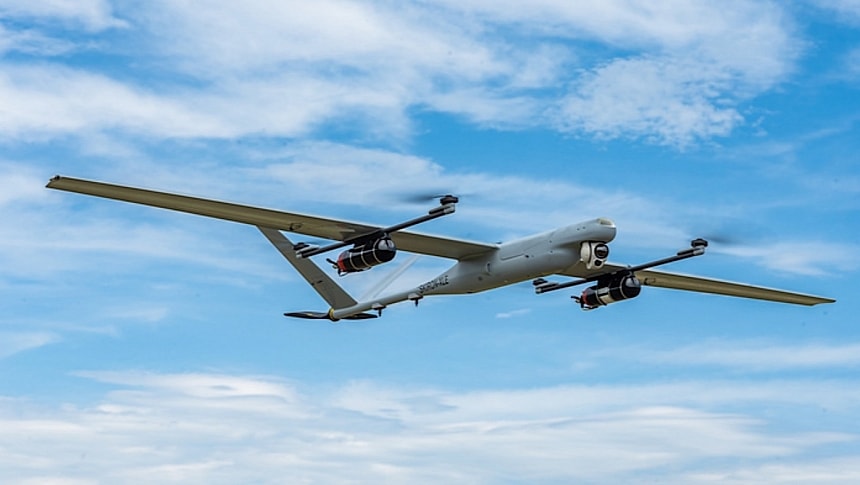Vertical take-off and landing (VTOL) drones are a common sight in the skies of the modern world, and we're used to seeing them go about their business in a helicopter-style configuration. But more and more companies are now working on fixed-wing VTOLs, because they bring together the ability to lift off and land pretty much anywhere with the ability to stay airborne for much longer periods of time.
The latest entry in the world of fixed-wing VTOLs that can be used for military or law enforcement purposes is something called the Skiron-XLE. The drone is the product of Boeing's specialized business Aurora Flight Sciences, and it builds on a drone that was originally born in November 2022.
The Skiron is technically a Group 2 unmanned aircraft system, meaning close to the smallest kind available according to a classification by the U.S. Department of Defense. How small? Well consider it can be transported in the back of a standard SUV or truck, and it only needs a crew of two people to be deployed.
The Skiron first came about as the X, a variant that measures seven feet (2.2 meters) long and has a wingspan of over 16 feet (five meters). Tipping the scales at 49 pounds (22 kg, takeoff weight), it can travel at speeds of 57 mph (92 kph).
The drone is not extremely capable as far as range is controlled. The maximum distance it can go to from its operator is eight miles (13 km), and probably that's what prompted Aurora into coming up with a new version of the drone.
This one is called Skiron-XLE, with the two extra letters in the name standing for long-endurance. That's because the drone can now travel to distances of up to 47 miles (75 km) from its point of origin and still be able to be commanded and controlled.
Furthermore, the flight endurance has grown from three hours in the X to five hours in the XLE. That increase was made possible by fitting the drone with a hydrogen fuel cell supplied by a specialist company called Intelligent Energy. On the X, power for the drone comes from a battery system.
Just like its smaller sibling, the XLE has been designed to to take on long-range reconnaissance roles. To handle such a task, it comes equipped with high-resolution EO/IR systems supplied by Trillium Engineering.
The drone can, however, be adapted for other uses as well, and it allows custom payloads to be fitted. For that, it even provides a belly-mount and under-wing payload spaces.
Aurora is currently at work testing the fuel cell drone. It doesn't say exactly when we are to expect to see it being used in the field, but production is already ongoing over at the company's facility in Manassas, Virginia.
The Skiron is technically a Group 2 unmanned aircraft system, meaning close to the smallest kind available according to a classification by the U.S. Department of Defense. How small? Well consider it can be transported in the back of a standard SUV or truck, and it only needs a crew of two people to be deployed.
The Skiron first came about as the X, a variant that measures seven feet (2.2 meters) long and has a wingspan of over 16 feet (five meters). Tipping the scales at 49 pounds (22 kg, takeoff weight), it can travel at speeds of 57 mph (92 kph).
The drone is not extremely capable as far as range is controlled. The maximum distance it can go to from its operator is eight miles (13 km), and probably that's what prompted Aurora into coming up with a new version of the drone.
This one is called Skiron-XLE, with the two extra letters in the name standing for long-endurance. That's because the drone can now travel to distances of up to 47 miles (75 km) from its point of origin and still be able to be commanded and controlled.
Furthermore, the flight endurance has grown from three hours in the X to five hours in the XLE. That increase was made possible by fitting the drone with a hydrogen fuel cell supplied by a specialist company called Intelligent Energy. On the X, power for the drone comes from a battery system.
Just like its smaller sibling, the XLE has been designed to to take on long-range reconnaissance roles. To handle such a task, it comes equipped with high-resolution EO/IR systems supplied by Trillium Engineering.
The drone can, however, be adapted for other uses as well, and it allows custom payloads to be fitted. For that, it even provides a belly-mount and under-wing payload spaces.
Aurora is currently at work testing the fuel cell drone. It doesn't say exactly when we are to expect to see it being used in the field, but production is already ongoing over at the company's facility in Manassas, Virginia.






